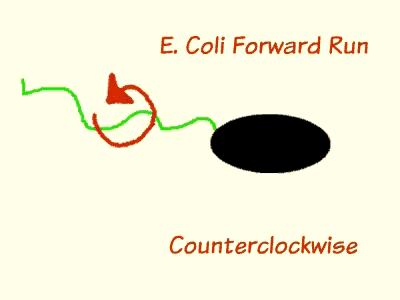Lecture 24
Bacteria Forward Motion & Tumbling
As previously discussed, most bacteria use flagella in order to achieve forward motion. Bacteria then tumble in order to change direction. Experiments have shown that bacteria in environments of high concentration of some attractant decrease their tumbling frequency.
It has been shown that after some longer time scale the bacteria’s tumbling frequency increases back to its normal rate. This time scale is referred to as the adaptation time. Now let’s try to explain this phenomenon through a model.
Chemotaxis Signaling Network
In this model we have inputs and an output.
- Inputs: Attractant, Repellents
- Output: Tumbling frequency
We will assume that tumbling frequency decreases upon attractant-receptor binding, and that adaptation occurs on a long time scale.
Our model will involve receptors and attractants (ligand). Receptors may be in either the active or inactive state, and in either state may be bound to an attractant. The active-unbound and the inactive-bound states are favored. All of these states may also be modified with (de)methylation and this process occurs on the order of minutes.
Simplest Model
Let’s first assume that there is no attractant present – this eliminates bound receptor states. In this case, transitions from the (in)active state is fast, and transitions from the (de)methylated state is slow.
\[\begin{align*} x &\equiv \text{Concentration of unmethylated receptors} \\ x_m &\equiv \text{Concentration of methylated receptors} \end{align*}\]In order to (de)methylate a receptor an enzyme needs to act on the receptor. There is an enzyme for methylation and a different one for demethylation.
\[\begin{align*} R &\equiv \text{Concentration of methylation enzyme} \\ \rho &\equiv \text{methylation rate} \\ B &\equiv \text{Concentration of demethylation enzyme} \\ \beta &\equiv \text{demethylation rate} \\ \end{align*}\]Lets also quantify the fraction of receptors that are active (and are not bound).
\[\alpha \equiv \text{fraction of receptors that are active}\]Michaelis-Menten Kinetics
Using Michaelis–Menten kinetics we can write the rate equations that our simple model obeys.
\[\begin{align*} \frac{dx}{dt} &= -\rho R \frac{x}{x+K_R} + \beta B \frac{x_m}{x_m+K_B} \\ \frac{dx_m}{dt} &= -\frac{dx}{dt} \end{align*}\]The enzyme \(R\) operates at saturation which implies that
\[\Rightarrow K_R << x \ \Rightarrow \rho R \frac{x}{x+K_R} \approx \rho R \ .\]Using this approximation we solve for the the steady-state solutions.
\[\rho R = \beta B \frac{x_m}{x_m+K_B} \\ \Rightarrow x_m = \frac{\rho R K_B}{\beta B - \rho R}\]The total output (or activity) \(A_0\) is the given by the concentration of active receptors.
\[A_0 = \alpha x_m = \frac{\alpha \rho R K_B}{\beta B - \rho R}\]After adding a ton of attractant the activity suddenly decreases since the fraction of active, unbound receptors sharply decreases.
\[\alpha \to \alpha' << 1\] \[\Rightarrow A_1 = \frac{\alpha' \rho R K_B}{\beta B - \rho R} << A_0\]Hypothesis: the enzyme’s demythaltion rate decreases when a lot of attractant is added to the system.
\[\beta \to \beta' <<\beta\]This decrease in the rate leads to a build-up of methylated receptors.
\[\to A_2 = \frac{\alpha'\rho R K_B}{\beta' B-\rho R}\]Exact Adaptation
In the case of exact adaptation this new activity level \(A_2\) will be equal to the original activity level before a lot of attractant entered the system.
\[A_2 = A_0\]This is hard to achieve in a system of cells because of variability between all of them. For example the concentration of enzymes varies from cell to cell and this will cause the new activity not to get back up to the original value. So we need to modify our simple model in order to try to get to a solution where we can recover the original activity.
Modified Model
Let’s assume that the enzyme \(B\) only demthylates active receptors. With this in mind lets assign a few new variables.
\[\begin{align*} x_m &\equiv \text{Concentration of active methylated receptors} \\ x_m^* &\equiv \text{Concentration of inactive methylated receptors} \end{align*} \\ \Rightarrow A = x_m^*\] \[\mu , \nu \equiv \text{rates of (de)activation of methylated receptors} \\ \alpha \equiv \frac{\mu}{\mu+\nu}\\\]Now the rate equations for a the modified model are the following
\[\begin{align*} \frac{dx_m}{dt} &= \rho R \frac{x}{x+K_R} + \nu x_m^* - \mu x_m \\ \frac{dx_m^*}{dt} &= - \beta B \frac{x_m}{x_m+K_B} - \nu x_m^* + \mu x_m \end{align*}\]Using the same approximation as in the simple model we can solve for the steady-state solutions.
\[\begin{align*} \rho R = -\nu x_m^* + \mu x_m \\ \beta B \frac{x_m}{x_m+K_B} = -\nu x_m^* + \mu x_m \end{align*}\] \[\Rightarrow x_m^* = \frac{\rho R K_B}{\beta B-\rho R} = A\]Now we have an expression for the steady-state activity \(A\). In this modified model \(A\) is not a function of \(\alpha\) – this is a good thing!
For example, in this model if attractant is suddenly added to the system then…
\[\mu \to \mu' << \mu \\ \alpha \to \alpha' << \alpha \\ A \to A\]The activity does not change! The property of exact adaptation is known as robust. Robust means that the quantity of interest is independent of parameter changes.
Written with StackEdit.

